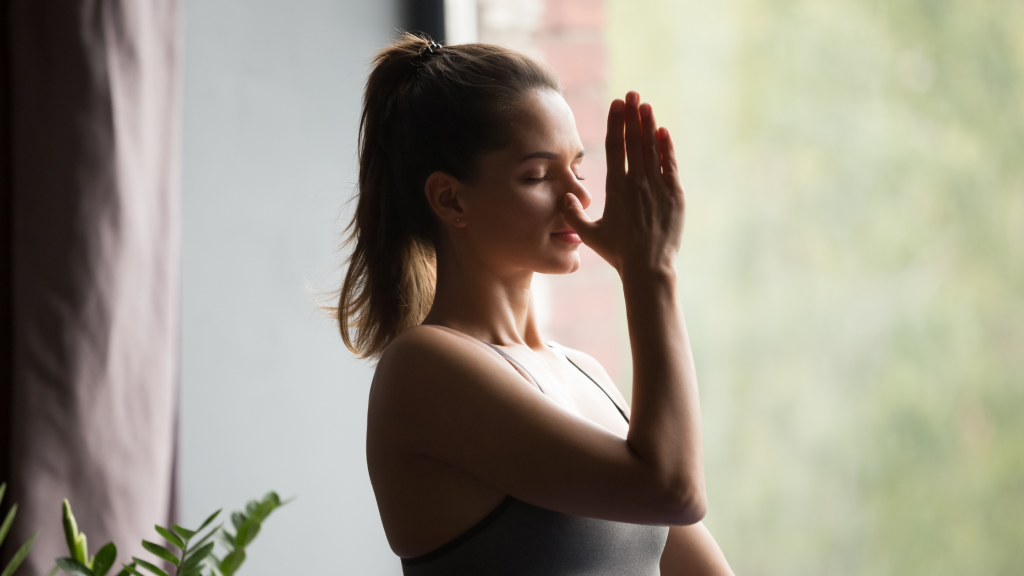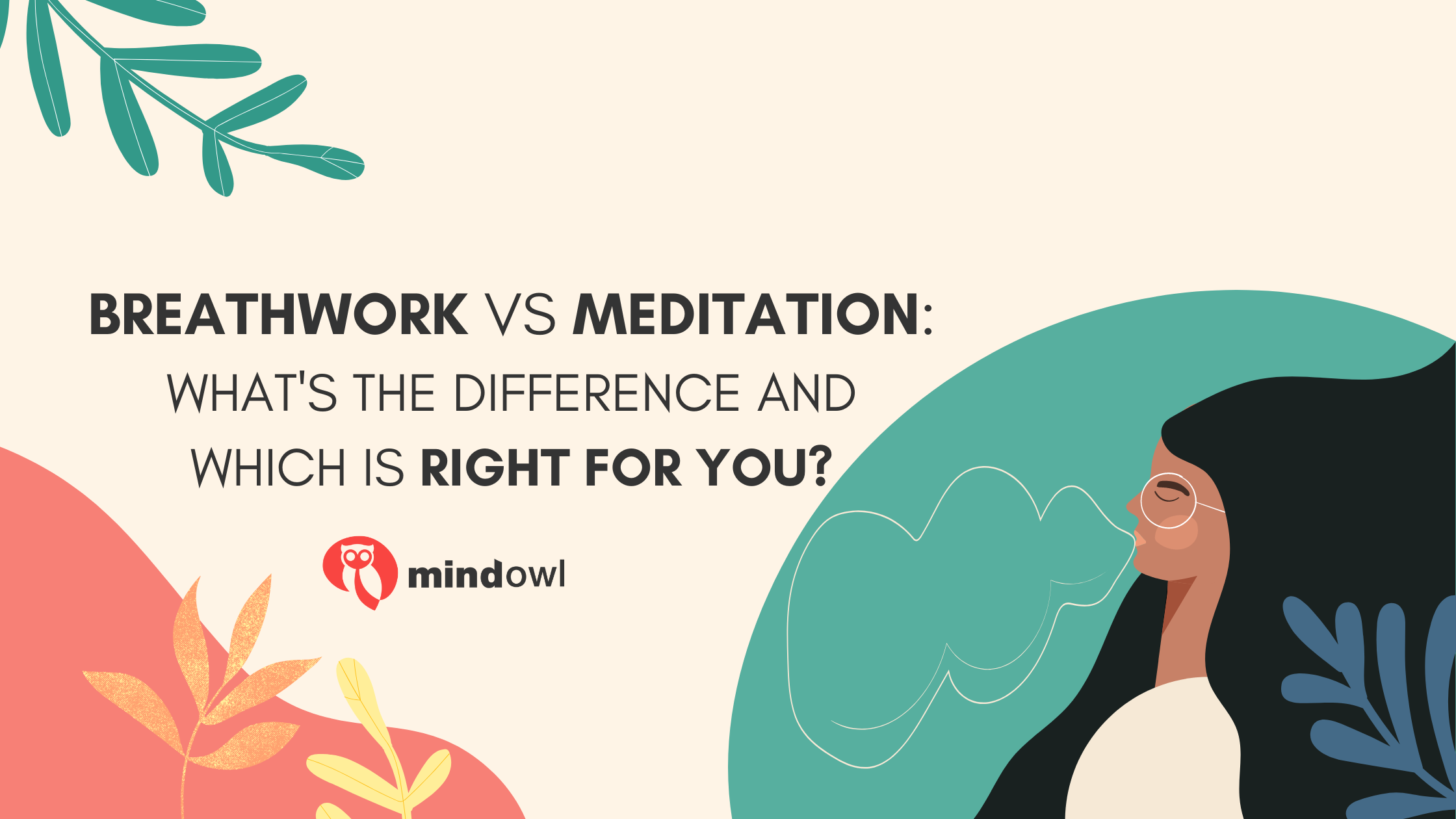Breathing is central to most forms of meditation. However, that doesn’t mean breathwork and meditation are the same thing. In fact, for many who struggle to sit down and concentrate on their thoughts, breathwork practices are becoming an increasingly viable alternative to traditional meditation.
While some people may substitute meditation for breathwork sessions, here at MindOwl we like to view these practices as complementary. Different people may find one method more attractive or effective than the other, but ideally, one would combine these approaches to get the best of both worlds. But before we delve deeper into that, let’s first flesh out the differences between meditation and breathwork.
What is the difference between meditation and breathwork?
It’s common to wonder what the differences are between meditation and breathwork. Is one better than the other? Put simply, the answer is no. However, there are advantages and disadvantages to each practice, as well as some key differences in praxis.
Meditation focuses on present moment awareness, and seeks to generate a more settled, focused mind. Practitioners can have various different motivations, but generally speaking, they are linked by a desire to foster well-being and reduce suffering. Meditation is about increasing your awareness of how you operate. It asks you to observe your breath without manipulating it, whereas breathwork is a form of active meditation which uses breathing practices to try and alter your mood or mindstate.
Breathwork exercises seek to affect the autonomic nervous system by altering either the amount of oxygen we inhale, or the amount of carbon dioxide we exhale. This exchange is important; exhaling too much CO2 (for instance during exercise or a panic attack) can cause dizziness or headaches, while restoring CO2 levels leads to greater calmness and relaxation. While we’re all aware that being stressed or relaxed can change the speed and depth of our breathing, few of us know that the opposite is also true: we can actually use breathwork to alter how we feel physically and mentally.
Breathwork vs Meditiation: is Breathwork an alternative to meditation?
Maybe you’ve tried meditation a few times, and you just can’t get your head around it. You get distracted, or bored, or fidgety, before giving up. Meditation requires a large amount of concentration and quiet, and this can be frustrating for some people. If this sounds familiar, breathwork could be a simpler, more accessible route towards a better quality of life.

What are the advantages of breathwork?
Firstly, it’s easy, free, and universal. You don’t need a shaman or teacher, and it’s already a part of your daily life. The lack of a barrier to entry makes breathwork less overwhelming than meditation, which can be particularly challenging for people with anxiety or attention deficit disorders, because it insists on stillness and full concentration. Breathwork on the other hand doesn’t require thinking, and it bypasses some of the mental conflicts which discourage people from meditation. Breathwork exercises also create serious endorphin rushes, while clearing energy from your body that you perhaps didn’t even know was there.
Pranayama
The importance of breathing has been clear to various cultures and societies for thousands of years. The Hindu yogic tradition Pranayama is responsible for developing some of the earliest breathing exercises. Pranayama is a Sanskrit word meaning ‘breath control’ or ‘control over prana‘, prana meaning a life force that can be harnessed by the breath. An enduring part of yoga practice today, Pranayama focuses on conscious breathing, with awareness and intent. A more conscious approach to controlling (yama) your breath (prana) can help remove emotional and energetic blocks in life, and allow us to cope better with anxiety, stress, fatigue and depression.
Breathwork exercises
Specially designed breathing exercises can seriously affect our moods, as well as producing various health benefits. Generally, different techniques will either calm us down, energise us, or find an appropriate balance between the two. This is because they’ll appeal to either the sympathetic nervous system (the activating part, which is more active during exhalation) or the parasympathetic nervous system (the calming part, which is activated when we inhale). Our article on how breathwork can supercharge your meditation dives deeper into the science of breathwork meditation; but for now, let’s focus on the practical aspects of a few specific techniques.
Balanced breathing
Balanced breathing means choosing a comfortable number of seconds to breathe in and out for, and trying to keep our breath at that rate for as long as possible. Try to breathe through the nose; this cleans, warms, and moistens the air you take in, causing slower, deeper breathing that engages the diaphragm, calms the mind, and regulates heart rate. As the name suggests, this technique seeks to balance us.
Square breathing
Used to help balance the autonomic nervous system, this method incorporates pauses between inhalation and exhalation. Square breathing follows a cycle of Breathe in, Hold, Breathe Out, Hold, spending four seconds on each step. Check out our easy guide to square breathing for more direction.
Calming Breath
This involves doubling the duration of our exhalation compared with our inhalation. If we inhale for 4 seconds, we’ll exhale for 8.
Energising Breath
Energising Breath exercises engage our sympathetic nervous systems, so they can generate a heightened, but healthy level of stress. One technique is to exhale too quickly, without allowing time to inhale, 30 times. Rest for a minute then repeat this process twice. Another method is to breathe in faster than normal 20-30 times, before releasing all the air on your last exhale and holding your breath for 30 seconds. Practise breathing patterns like this when you feel tired or sleepy, instead of just grabbing a coffee. They can help you reset and reconnect with your surroundings.
Breathing imagery
If you’re struggling to sleep at night, this technique can be useful. Breathing imagery relaxes you by directing thoughts away from catastrophizing and onto the physical breath. Here, you lie flat on your back and focus on the relaxing feeling of exhalation. Become aware of the sensations of your body against the mattress, its weight, and the slowing down of your mind on each exhale. Imagine your exhales as colours or images; what do you see?
Holotropic Breathwork (Warning: Do not try without a trained professional)
Holotropic Breathing was first invented in the 1970s to treat patients with mental health conditions. In this practice, the participant lies down in a dark room, and breathes as heavily and as quickly as they can. This exhales a lot of CO2, reducing blood flow to the brain. The technique can cause changes in body temperature, hallucinations, out-of-body experiences, and psychological clarity; therefore, it is often utilised as a spiritual practice, or to achieve psychedelic states. Creating this sense of panic is an extreme method; however, it can produce intense self-reflection, plus reverting back to normal breathing afterwards can induce a strong state of calmness.
Rebirthing
Grounded in the idea that we all carry residual stress from the trauma of birth, rebirthing breathwork seeks to help you release this baggage. Also generally led by an instructor, this type of breathwork involves lying mostly underwater and practising ‘circular breathing’ – quick, shallow breaths without any breaks between an inhale and an exhale. This kind of conscious breathing is designed to release pent-up stress and tension.
Transitioning from breathwork to meditation
We’ve now taken a look at various types of breathing exercises. It’s worth trying as many of these as possible until you find a set of exercises that work for you, resulting in a unique, effective routine. But how can you use breathwork as a gateway into meditation? Below are some activities which merge the two in an accessible way.
Tune into your body during breathwork
A full breath cycle involves your chest, belly, back, and mind. To channel the attentiveness and concentration of meditation, tune into your body when practising breathwork. Focus on the physical elements of your breath and follow these steps:
- Watch your belly rise and fall.
- Notice the temperature and moisture of your breath.
- Take note of the muscles and bones moving in your body.
- Observe the differences between shallow and deep breathing.
Notice your mind’s response to breathwork
Intertwining meditation and breathwork can calm the mind, increase focus, and aid people with mental health issues. Focusing on your mind’s response to breathwork leads towards the mental and emotional self-awareness that underpins meditation.
- Make a note of the thoughts in your head, but try not to attach to them.
- Don’t suppress the emotions that come up, feel them, while maintaining your breath pattern.
- Be aware of your inner voice.
- Consider the intentions you’ve set for your breathwork practice.
Let’s get spiritual
Some people practise breathwork and meditation for spiritual reasons. This means moving beyond the body and mind to remove the ego, and connect to your true self and the universe. One of the ways to transition from breathwork into meditation is to make your practice more spiritual. If this interests you, try this:
- During inhalation, think about the universe filling you with air.
- Experience the life force, or prana, flow through you, and make space for it.
- Try to feel yourself connecting with a deeper part of yourself.
- As you exhale, connect with and send energy to your surroundings.
In Conclusion
If you find yourself struggling with meditation, focusing on breathwork can be a great way to get used to some of the basics of the practice. Breathwork modalities can help you calm your mind and reduce stress, while also giving you the ability to release stagnant body energy or dormant trauma you didn’t realise was there. Breathwork exercises can also be used to help you energise or psych yourself up. The flexibility provided by different exercises makes breathwork highly appealing to many.
However, practising breathwork alone without considering meditation means you’re missing out on all sorts of benefits. Yes, meditation is a more advanced practice, so it can be tricky at times. Nonetheless, breathwork alone won’t allow you to grow your awareness of your mind and engage with your own thoughts, emotions and triggers in the way meditation facilitates. If you want to see significant personal growth, use breathwork as a way of getting accustomed to the fundamentals of meditation, then merge the two practices. Try a number of different exercises until you figure out what works for you.
Getting used to calming your body and mind through breathwork will allow you to practise meditation with fewer distractions and greater connection to your thoughts and emotions. This means it can represent a great gateway practice. Ideally, once you feel confident practising breathwork, you’ll incorporate these techniques into meditation practice. Once you feel comfortable progressing onwards, start thinking about which meditation style could be best for you.
MindOwl Founder – My own struggles in life have led me to this path of understanding the human condition. I graduated with a bachelor’s degree in philosophy before completing a master’s degree in psychology at Regent’s University London. I then completed a postgraduate diploma in philosophical counselling before being trained in ACT (Acceptance and commitment therapy).
I’ve spent the last eight years studying the encounter of meditative practices with modern psychology.



